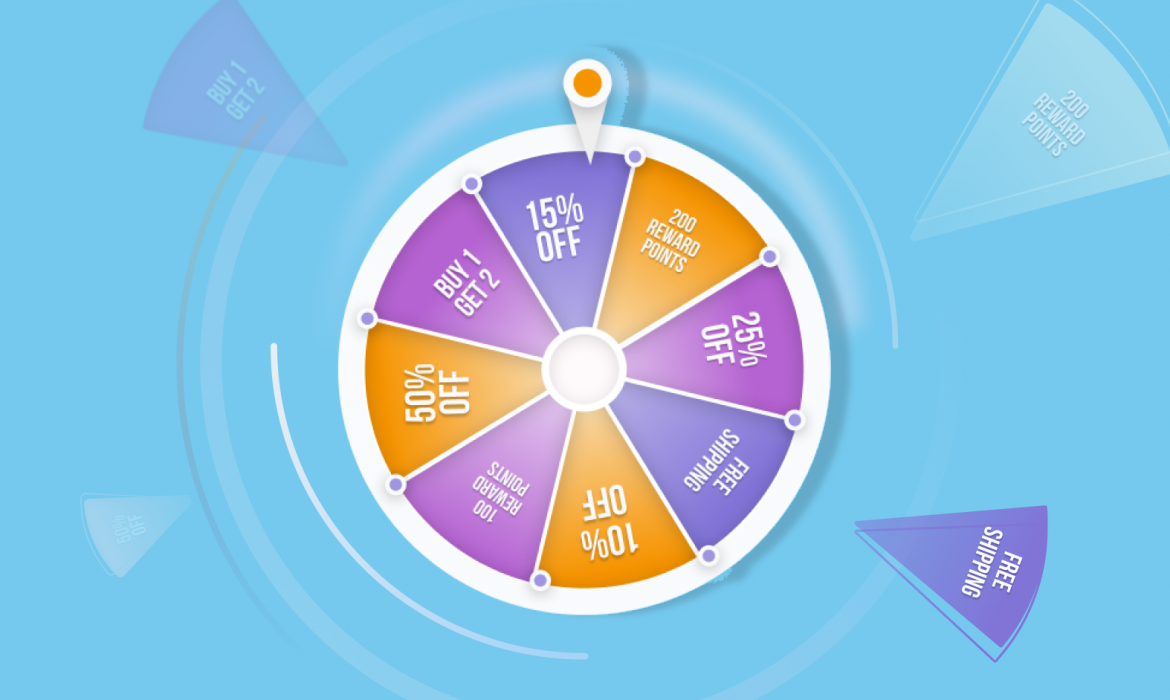
Updated 27.11.2025
Gamified web popups and mobile widgets shift the numbers. Spin-to-win stands out because it turns passive visitors into participants. The stats are clear. Popups using spin-to-win convert at 8.67%, outperforming standard popups (3.70%) by 132%.
This post shows how to apply the best spin-to-win practices on both web popups and mobile app widgets. You’ll see the core psychology, the design choices that lift results, the industries that benefit, and the ways to tie each spin outcome to automated journeys.
The Psychology Behind Gamified Spin-to-Win
The spinning wheel creates both uncertainty and anticipation. Users don’t know which prize they’ll win until the wheel stops. That tension captures attention in ways static offers can’t match, which leads to a stronger purchase intent compared to traditional approaches.
Unlike hidden discounts or vague “exclusive offers,” spin-to-win shows all possible prizes upfront. Users see what they might win before sharing their information. Trust matters more than you’d think: 68% of consumers rank it as the most important factor in brand loyalty, above even price and convenience.
Web Popups vs. Mobile App Widgets: Choosing the Right Format

Web Popups for Acquisition
Web popups excel at capturing new visitors. A user lands on your product page, browses for 20 seconds, then sees a spin wheel offering 10-50% off. They enter their email, spin, and win a discount code.
This format works for:
- E-commerce stores building email lists
- SaaS companies capturing trial signups
- Content platforms growing newsletter subscribers
- Telecom companies promoting plan upgrades or data add-ons
Research analyzing over 26,000 campaigns found that timer-led triggers outperform scroll-based triggers by 67%, with 6 seconds being optimal.
Mobile App Widgets for Retention
Mobile app widgets have obvious advantages including:
- Dormant user reactivation
- Richer behavioral data for targeting
- Direct connection to in-app features
- Seamless reward redemption.
Need proof? Bi’Talih, a betting platform, used Netmera’s mobile spin-to-win widgets to increase engagement. The gamification feature led to a 30% increase in both daily and monthly active users. Conversions doubled. The retention rate reached 70% after 28 days.
Best Spin-to-Win Practices for Success

1. Match Prizes to User Intent
New visitors: Higher percentage discounts or free shipping
Returning browsers: Product bundles or “complete the look” offers
Cart abandoners: Time-sensitive codes with 24-hour expiration
Loyalty members: Early access to new collections or VIP perks
Set probabilities so higher-value prizes appear less frequently while smaller incentives show more often. Control your budget while maintaining perceived fairness.
2. Design for Your Brand

Netmera’s widget builder lets you adjust colors, fonts, button styles, and each slice design with no code, ensuring consistency across web and mobile. Use brand colors, clear prize labels, and readable text at all screen sizes.
3. Time Triggers Right
Research found timer-led triggers outperform scroll-based triggers by 67%, with 6 seconds being optimal. For better user experience, consider waiting 15-30 seconds or until users scroll 50-70% down the page. Target specific pages like pricing or checkout.
4. Optimize for Mobile
Prioritize touch-friendly spin buttons, fast loading (under 2 seconds), minimal form fields, and one-tap prize copying. Test across devices and screen sizes.
5. Add Urgency Without Aggression
“Spin now – offer expires in 24 hours” converts better than open-ended promotions. Avoid popups on every page load, as these frustrate users.
6. Follow Compliance Rules
Review local laws governing sweepstakes and prize promotions. Follow regulations for collecting consent. Set frequency limits to prevent multiple spins.
7. Use Clear CTAs
Use action-oriented language like “Spin Now” or “Win up to 50% off!” to encourage participation and set clear expectations.
8. Track and Measure Results
Monitor widget performance with metrics like participation, conversion to qualified leads, and completed actions. Use A/B testing to refine placement, timing, and messaging. Regularly review data to improve campaigns and ROI.
Industry-Specific Use Cases: How Different Sectors Win with Gamification
Below are real results from Netmera customers who used gamification widgets, plus illustrative scenarios showing how other industries apply the same strategy.
Gaming and Entertainment

Bi’Talih integrated a Spin to Win widget with gamification features. The strategy led to a 30% increase in both daily and monthly active users. Conversions doubled. Retention rate reached 70.1% after 28 days.
Consumer Tech Apps
Walkers combined spin-to-win gamification with data-driven messaging. The dual approach increased retention rates by 10.9% after 28 days while overall active user count grew 11.87%.
E-commerce
Turkcell Pasaj achieved 150% revenue increases with automated cart recovery campaigns. Adding spin to win takes this further: users who abandoned carts see a widget offering a discount, and the game element reengages them while the discount removes price friction.

Banking and Fintech
Tam Finans and DenizBank used behavioral campaigns to reactivate users and fix conversion drop-offs. Financial apps can use spin-to-win for onboarding rewards, promoting bill payment features with fee waivers, or encouraging savings goal creation with interest rate boosts.
Telecommunications
Turkcell improved customer satisfaction scores 13% through targeted in-app campaigns. Telecom companies can deploy spin-to-win when data usage drops or app logins decrease. This proactive approach prevents churn by addressing disengagement early.
Connecting Gamification to Customer Journeys
Spin-to-win drives both acquisition and retention. To sustain the momentum, track results and automate follow-ups with Netmera.
Event Tracking Creates Segmentation Opportunities

Netmera automatically tracks five spin-related events:
- Spin To Win Shown – Widget displayed to user
- Spin Button Clicked – User initiated spin
- Coupon Code Assigned – User won prize
- Coupon Code Assigned Failed – Technical issue prevented prize assignment
- Coupon Code Copied – User copied prize code
These events feed unified customer profiles on Netmera. You can build segments based on spin behavior: users who saw the widget but didn’t click, users who won but didn’t redeem, users who redeemed and made purchases.
Automated Omnichannel Engagement Based on Spin Actions
Scenario 1: Non-Spinners
User sees spin widget but doesn’t engage. Twenty-four hours later, an email arrives: “You missed your chance to spin yesterday. Here’s a direct 15% discount.” This recovers users who showed interest but didn’t act.
Scenario 2: Winners Who Don’t Redeem
User spins, wins 20% off, copies the code, then leaves. Three hours pass with no purchase. An SMS triggers: “Your 20% discount expires in 21 hours. Complete your order now.” Urgency pushes them toward conversion.

Scenario 3: Converters Enter Loyalty Flow
User spins, wins, redeems, and purchases. They automatically enter a post-purchase journey: Thank you email at Day 1, product recommendations at Day 3, feedback request at Day 7, loyalty program invitation at Day 14.
Netmera’s Journey Builder makes this automation possible without code. Drag-and-drop logic creates paths that respond to user actions in real time. With one campaign, trigger multiple channels: push, web pop-ups, email, SMS, and in-app messages.
Key Metrics for Spin-to-Win Campaigns
You’ve set up spin-to-win with the best practices we covered and linked it to omnichannel journeys with Netmera. Next, let’s look at the metrics to track.
Engagement Metrics
- Widget display rate: Percentage of eligible users who saw the spin widget
- Spin rate: Users who clicked vs. users who saw the widget
- Completion rate: Users who spun vs. users who entered information (or copied the code)
- Prize distribution: Which rewards users won
Conversion Metrics
- Redemption rate: Users who actually used their prize codes
- Time to redemption: How quickly winners converted to purchases
- Average order value: Revenue per spin-winner vs. non-participants
- Repeat purchase rate: Whether spin participants return for future transactions
Journey Metrics
- Email/SMS open rates: For follow-up messages triggered by spin behavior
- Cross-channel engagement: How spin participants respond across push, email, SMS
- Retention lift: Compare 30/60/90-day retention for spin participants vs. control group

Spin-to-Win Mistakes to Avoid
One-fits-all Prizes
Prize value depends on your goal, segment, and desired impact. Start with offers compelling enough to overcome skepticism, then test variations.
Overly Aggressive Timing
Visitors haven’t had time to evaluate your product or understand your value proposition. Wait until they show engagement through scrolling or time on site.
Ignoring Mobile Experience
Spin widgets must work perfectly on phones where most users interact with your brand. Small buttons, slow loading, and unclear instructions kill mobile conversions.
No Follow-Up Strategy
Build automated welcome sequences, cart abandonment flows, and re-engagement campaigns that trigger based on spin behavior.
Treating It as One-Time Acquisition
The real value comes from turning spin participants into repeat customers. Track long-term metrics like customer lifetime value, not just initial conversion rates.
How Netmera Makes Spin-to-Win Work at Scale

No-code widget builder lets teams launch spin campaigns without developer support. Choose templates or customize designs to match your brand. Set prize probabilities, targeting rules, and display triggers through a visual interface.
Unified customer profiles capture every spin interaction alongside all other behavioral data. Mobile app usage, website browsing, email engagement, and purchase history live in one place. This complete view enables precise segmentation.
Journey orchestration connects spin results to automated follow-ups across push notifications, email, SMS, and in-app messages. Build multi-step flows that adapt based on whether users spin, win, redeem, or purchase.
Real-time analytics show spin performance as it happens. Identify drop-off points and optimize campaigns while they’re still live.
Your Spin-to-Win Implementation Checklist

1. Define your goal
List growth, cart recovery, or feature adoption? Your objective determines prizes, targeting, and metrics.
2. Choose your channel
Web popups for acquisition, mobile widgets for retention.
3. Set prize values
Control distribution via probability settings. Higher-value prizes appear less frequently while smaller incentives show more often.
4. Design your widget
Match brand aesthetics. Keep copy concise. Test mobile tap-friendliness across devices.
5. Build follow-up journeys
Automate emails for non-redeemers, SMS for expiring codes, loyalty flows for converters.
6. Track and optimize
Monitor engagement, redemption, and revenue. A/B test timing, prizes, and design.
With Netmera, you can design & launch spin-to-win campaigns without code, connect results to automated journeys, and track performance in real time – from one platform. Schedule a demo to see how it works.
FAQs
Both work for different goals. Web popups excel at acquisition, capturing new visitors and building email lists. Mobile app widgets focus on retention, reactivating dormant users and encouraging feature adoption.
Yes. Both gamify engagement and collect valuable data. Spin-to-win drives immediate conversions through discounts, while rewarded surveys gather customer preferences. Use spin-to-win for acquisition, surveys for insights and personalization.
Set frequency limits: one spin per day or per visit. Cache coupon codes so users can’t receive multiple unique codes for the same offer. Netmera handles these safeguards automatically through its widget builder.
Prizes need to match user intent and journey stage. New visitors respond to higher percentage discounts or free shipping. Returning browsers want product bundles. Cart abandoners need time-sensitive codes. Loyalty members value early access or VIP perks.
Every spin interaction triggers automated follow-ups. Non-redeemers receive reminder emails. Converters enter loyalty flows. Non-spinners get direct discount offers. Netmera tracks each spin event that feeds unified customer profiles and triggers omnichannel campaigns automatically.
Burcu Ulucay
Content Marketing, Netmera
